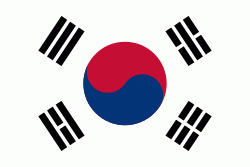Mungyeong
 |
The city of Mungyeong was created after Jeomchon City and rural Mungyeong County were combined in 1995. It is now an urban-rural complex similar to 53 other small and medium-sized cities with a population under 300,000 people in South Korea.
The Mungyeong area is believed to have been controlled by a mixture of Jinhan and Byeonhan states during the Samhan period in the first centuries of the Common Era. The Jinhan state of Geungi-guk may have been located near Sanyang-myeon. Byeonhan states such as Sabeol-guk and Gosunsi-guk, which probably controlled the Hamchang area of Sangju, may also have extended their control over adjacent areas that are now part of Mungyeong. However, this stage of local history is almost entirely hypothetical, since very little evidence of any kind remains.
At any rate, the rising power of Silla controlled the area by 505. Capitalizing on the territory's strategic potential, Silla set up various mountain fortresses in the area to control movement in and out of western Korea. Control of transit through the area would have gained even greater importance after Silla's 553 seizure of the Han River valley on the western side of the mountains. At this time the low Haneuljae pass near Poam Mountain was probably the favored crossing, in contrast to the higher Mungyeong Saejae pass which came into favor in the Joseon period.
As Silla reorganized its administrative structure under King Seongdeok in 757, the Mungyeong area was placed under the province of Sangju, and divided among various hyeon, or local districts. During this Unified Silla period the temple of Gwaneumsa, of which all but a few traces have vanished, was constructed near Haneuljae in present-day Mungyeong-eup.
In the early Goryeo period, in 983, King Seongjong reorganized local government yet again. Most of Mungyeong remained divided into assorted hyeon, under the central jurisdiction of Sangju. In 1390, Mungyeong-gun (Mungyeong County) begins to appear in the records, although not with its current boundaries.
In the Joseon period, the Eight Provinces were laid out and thus Mungyeong became part of Gyeongsang, which it remains. During later Joseon times, the road from Seoul to Busan was established running over Mungyeong Saejae. Beginning in the 18th century, gates were erected on the road to control traffic and protect travelers from brigandage. These gates are still preserved today.
The first railroads were constructed in the area during the period of Japanese occupation. Jeomchon Station was opened on December 25, 1924. However, the pace of resource extraction did not accelerate greatly until the post-war period, under the first South Korean government led by Syngman Rhee. Construction on the Gaeun Line, with the goal of improving access to the coal deposits around Gaeun, began on January 18, 1953, before the official end of the Korean War (the line was completed in 1955).
Local self-governance was established in the early years of the Republic of Korea, but abruptly cancelled following the military coup of 1961. After the end of military dictatorship, local representative government was reinstituted in 1991. At that time, the present-day territory of Mungyeong was divided between Jeomchon City and Mungyeong County. The city acquired its present-day borders on January 1, 1995, when the two former units were merged to form Mungyeong City.
Map - Mungyeong
Map
Country - South_Korea
 |
 |
| Flag of South Korea | |
The Korean Peninsula was inhabited as early as the Lower Paleolithic period. Its first kingdom was noted in Chinese records in the early 7th century BCE. Following the unification of the Three Kingdoms of Korea into Silla and Balhae in the late 7th century, Korea was ruled by the Goryeo dynasty (918–1392) and the Joseon dynasty (1392–1897). The succeeding Korean Empire (1897–1910) was annexed in 1910 into the Empire of Japan. Japanese rule ended following Japan's surrender in World War II, after which Korea was divided into two zones; a northern zone occupied by the Soviet Union and a southern zone occupied by the United States. After negotiations on reunification failed, the southern zone became the Republic of Korea in August 1948 while the northern zone became the communist Democratic People's Republic of Korea the following month.
Currency / Language
| ISO | Currency | Symbol | Significant figures |
|---|---|---|---|
| KRW | South Korean won | â‚© | 0 |
| ISO | Language |
|---|---|
| EN | English language |
| KO | Korean language |















